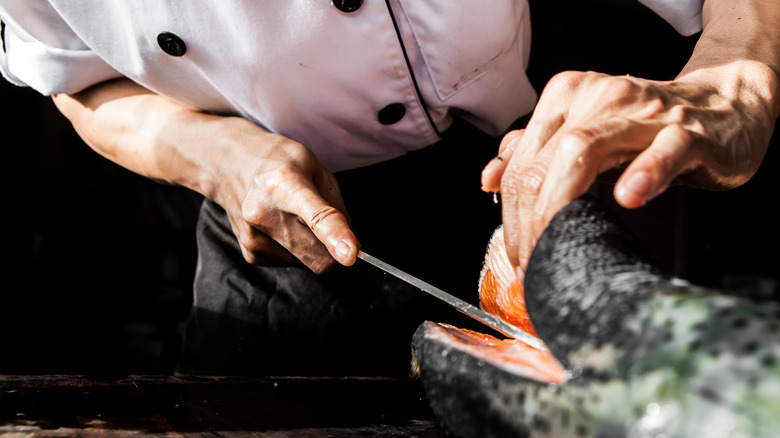The Real Difference Between Smoked Salmon And Lox
Nothing says "good morning" like a Sunday visit to your favorite deli. A mug of strong, tasty coffee is in order, as is a crisp, chewy sesame bagel lathered with schmear and topped with spicy red onion, salty capers, a slice of ripe tomato, and a pile of smoked salmon. Or is it lox? In your eyes, it doesn't really matter so long as the fish is tender and delicious. Often, smoked salmon and lox are used interchangeably. After all, they look the same and pretty much taste the same. Whatever it is, it makes a fine addition to your party canapés, sushi rolls, and scrambled eggs.
Both lox and smoked salmon are cured fish, or fish preserved in salt. History says that the practice of salt curing dates back to ancient Egypt, you know, way before refrigerators came into play. Salt naturally draws out the moisture of fish and meat, essentially bringing bacteria growth to a halt so the meat can stay safely edible for a longer period of time. While born out of necessity, it's quite uncanny that the practice of salt curing is still widely practiced today, not only with fish, but in the form of jerky, charcuterie meats and, of course, bacon. Smoked fish like cod, herring, and anchovies are hugely popular in Scandinavian and European countries, but lox and smoked salmon are probably the most eaten types in America, according to Taste Atlas. Interchangeable, yes. Exactly the same? Far from it.
How different can they be?
Lox comes from the Yiddish word "laks," which means "salmon." Traditional lox is made by taking the meat from the salmon's belly and curing it in salt or in a salt brine, according to Food & Wine. After a few days in the fridge, the fish should be ready to serve, per The Spruce Eats. It is sliced paper thin and used as desired. Naturally, it is salty, but the flavor of the salmon should also come through, which is why it is preferable to use the fatty, delicious belly portion.
There are two major factors that make smoked salmon different from lox. First, smoked salmon can be any part of the salmon, not just the belly. It's not unusual for an entire salmon filet to be used in making smoked salmon. The preparation process begins exactly the way it is for lox — it is salt-cured first. But, as the name suggests, smoked salmon is then smoked in one of two ways; if it is cold smoked, the result is much like lox. It is served sliced very thinly and appears to be raw. If it is hot smoked, what results is a filet that appears and tastes like fully cooked salmon, per MasterClass. This type is typically flaked or cut into chunks. If making at home, it's probably simpler to make your own lox, unless you're experienced with a smoker, and, of course, if you're willing to sacrifice those leisurely Sunday trips to the deli.

